Papers by Dr. Gehan Dhameeth
Research in Economics and Management
Organizational leaders use many management tools when planning and controlling. One of the most w... more Organizational leaders use many management tools when planning and controlling. One of the most widely used is the Balanced Scorecard (BSC) metrics. Based on a literature review method used, this paper explored the dynamics that influence organizations to overlook the inputs of managerial accountants when using BSC when measuring organizational performance. We found that a misfit between the strategy of the firm and the firm’s internal capabilities and skills and the inability of the financial perspective to predict and improve financial performance to be predominant factors to overlook the inputs of managerial accountants when using BSC.
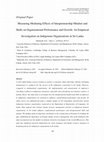
Research on Economics and Management, 2021
A well-crafted human resource strategy to nurture a corporate culture that helps cultivate risk-t... more A well-crafted human resource strategy to nurture a corporate culture that helps cultivate risk-taking intrapreneurs is conducive for the success of the indigenous corporation in Sri Lanka. However, compared to multinational organizations, the implementation and measurement of employee’s risk-taking readiness in indigenous enterprises, especially when introducing new business ventures, is lacking. Hence, this study aims to investigate how the intrapreneurial mindset and skills of employees in indigenous organizations are nurtured to influence organizational performance and growth. An online survey was administered using a random sample of 322 respondents selected from various indigenous business organizations registered at the Department of Registration of Companies, Sri Lanka. Data suggests that strategic human resource management activities at indigenous business organizations in Sri Lanka influence organizational performance and intrapreneurial skills and mindset. The findings ma...
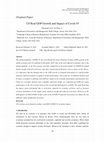
Research in Economics and Management, 2021
The global pandemic, COVID-19, has exacerbated the Gross Domestic Product (GDP) growth of the glo... more The global pandemic, COVID-19, has exacerbated the Gross Domestic Product (GDP) growth of the global economy since its outbreak in December 2019. One of the most affected economies, due to the global pandemic, is the US economy, currently crippled by an increased number of COVID-19 related deaths, layoffs, reduced work hours, and other related natural disasters, such as winter storms. Hence, it is imperative that the damage done to the GDP growth is evaluated meticulously to craft favorable monetary and fiscal policies to uplift economic performance. One of the key yet debated methods used by many economists is utilizing real GDP per capita as an economic performance measurement tool. Using two economic datasets and a multiple regression model, we compared real GDP per capita performance in the US economy between the second and third quarters of 2020. The study finds that the impact seems detrimental due to restrictions imposed on economic activities, such as business closures, dist...

Due to topographic circumstances, the Finger Lakes Region of New York is capable of producing win... more Due to topographic circumstances, the Finger Lakes Region of New York is capable of producing wine; albeit the region is limited by the climate and soil types of this region. While the potential is apparent to viticulturists and oenologists, the consumers seem to be unaware or unconscious of these abilities and hold the area to standards outside of its capabilities; in regards to both volume production and varietal preference. Since the region is a consumer driven area, the relationship has been developed with wine that evolves around consumption; this emphasizes volume production that is only possible via machine practices. This use of mechanization is what fosters a disconnect between producer and product: an alienation of the vines, vintner and winemaker. This paper analyses the value construction or destruction at the point of producing and consuming wine in the Finger Lakes Region of New York.
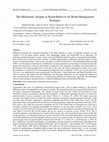
Journal of Management and Strategy
Millennial generation has surpassed generation X and Baby Boomers in terms of population (market)... more Millennial generation has surpassed generation X and Baby Boomers in terms of population (market) size and standout to be the largest market segment. This demographic change will undoubtedly be an opportunity for marketing and brand managers to reach, acquire, and retain Millennial market to achieve organizational profitability. Prior research has not been successful to provide a detailed understanding of Millennials and their degree of brand loyalty over prior generations. In this article, the authors used Kevin Lane Keller’s work (Brand Resonance Pyramid 2009) to test the degree of brand loyalty of Millennials over prior generations and the degree of brand resonance that predicts the brand loyalty while this relationship is moderated by the generation. In addition, they determined how the elements of the brand pyramid relate to each other. In this study, the authors administered an online survey using SurveyMonkey to reach local (US) and international college/university respondent...
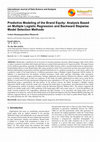
International Journal of Data Science and Analysis
Brands play a significant role at the point of consumer purchases decisions. Brand managers make ... more Brands play a significant role at the point of consumer purchases decisions. Brand managers make all the efforts to induce consumers to purchase their brands and increase eventual brand associations for long-term profits. This paper focuses on how different generations, especially the Millennial and the Baby boomers, behave towards brands based on organizations' brand building efforts to create Brand Equity (BE) using a predictive model. Prior research has not been successful to provide a detailed understanding of generations and their potential brand behavior in a predictive perspective. In this article, author used a predictive model of the brand behavior of different generations using a Multiple Logistic Regression (MLR) method. In addition, it is determined how the predictor variables (awareness, recall, relate, purchase, knowledge, trials, association, recommendations, salience, imagery, performance, feelings, judgement, and resonance) influence the response variable, brand equity, to predict brand equity in these two audiences. In this study, the author administered an online survey using Survey Monkey to reach local (US) and international college/university respondents (n=267) age 18 years and above. The survey was administered using a questionnaire (46 data points). In the analysis process, the author developed a Multiple Logistic Regression (MLR) model, tested the model error, predicted the brand equity of generations, and determined the best model with parsimonious number of predictor variables using the Backward Stepwise Method (AIC). The analysis suggested the model to be reliable model with a 100% prediction of the brand equity (BE) with a mean value of 1. Given the predictors, the model correctly predicted 63% respondents, millennial and baby boomers, to be associated with brand equity and 35% respondents to be otherwise, while the Best Model based on the Backward Stepwise Selection Method (BSSM) using Step AIC function, suggested thirteen out of fourteen predetermined predictors included in the model to predict Brand Equity (BE). In the results generated, the AIC value indicated was 106.
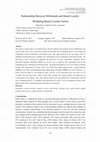
Journal of Business Theory and Practice
The purpose of this study is to identify factors (brand elements) that mediate between Millennial... more The purpose of this study is to identify factors (brand elements) that mediate between Millennials and brand loyalty, and to test a theoretical model that includes these mediating factors in describing the relationship between millennials and brand loyalty. The study focused on the key factors that we identified and hypothesized to mediate the relationship between millennials and brand loyalty. The quantitative study surveyed two hundred and fifty-three (n=253) respondents randomly drawn. Structural Equation Modelling (SEM) was used to test a model of the relationship between the mediating factors, millennials and brand loyalty. All model fit parameters were well within acceptable bounds. The Comparative Fit Index (CFI) was 0.999, Root Mean Square Error of Approximation (RMSEA) was 0.018, and Standardized Root Mean Square Residual (SRMR) was 0.022. However, we believe that the model is over-fitting the data, and this is not surprising given that there are 22 variables and 253 data points. These results show promise, but require further investigation in a second phase of the inquiry. This study limited itself to surveying millennials, brand loyalty, and the seven mediating factors we identified and hypothesized to play a role in mediating between them. Based on this study, brand management strategies are proposed.








Uploads
Papers by Dr. Gehan Dhameeth